Lieutenant Fleming William Suiter (1922-1946)
Written and researched by Sharon Erickson Harman © June 2023

 Fleming William Suiter was born on August 26, 1922, in Chesapeake, Lawrence County, Ohio. He was the second surviving child of Roscoe William and Blanche (Bruner) Suiter.
Fleming William Suiter was born on August 26, 1922, in Chesapeake, Lawrence County, Ohio. He was the second surviving child of Roscoe William and Blanche (Bruner) Suiter.
Fleming’s oldest brother died as an infant in 1918. Fleming had an older sister, Genevieve Ruth, and two younger brothers, Kenneth B. and Roland Darby.
Fleming Suiter grew up in Chesapeake, Ohio, but graduated from Central High School in Huntington, West Virginia, across the Ohio River from Chesapeake.
He attended Marshall College (now Marshall University), Huntington, West Virginia, until he enlisted in the Army on June 9, 1942.

His enlistment papers identify the following personal data: brown eyes, brown hair, ruddy complexion, height of 5’9”, and good physical condition. He was sent to Santa Ana, California, for his initial training, and he retained a fondness for his first squadron at Santa Ana.
Fleming began training as an Aviation Cadet on July 6, 1942. He trained with the Army Air Force Flying Training Detachment at Mira Loma Flight Academy, Oxnard, California (September 30 – December 4, 1942), followed by the Army Air Forces Basic Flying School Minter Field, Bakersfield, California (December 4, 1942 – February 4, 1943) and finally at the Army Air Forces Advanced Flying School, Williams Field, Chandler, Arizona. On April 12, 1943, Fleming graduated as a Pilot at Williams Field and was commissioned as Second Lieutenant in the Air Corps Reserve.
By June 1943, Lt. Fleming W. Suiter, 0743383, was a member of the 338th Fighter Squadron, 55th Fighter Group, (TE) AAF, stationed at McChord Field, Tacoma, Washington, where he received a commendation that read:
…for the excellent manner in which you handled your P-38 airplane on June 17, 1943, when the left super-charger blew up. Although injured, your technique and judgement were outstanding. Your actions during this emergency reflects great credit not only upon yourself but upon the organization which you are assigned. The undersigned is proud to have you as a member of this command.
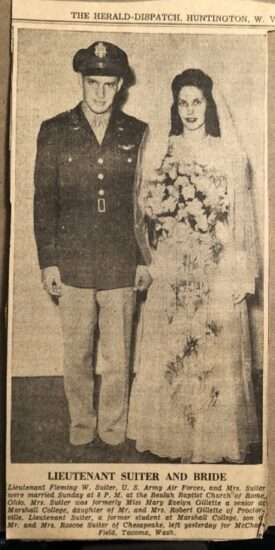 Lt. Suiter married his sweetheart May Evelyn Gillette of Rome Township (near Proctorville, Ohio) on July 25, 1943, at Beulah Baptist Church in Rome Township, Lawrence County, Ohio. Five days later, Lt. Suiter was back at McChord Field, Tacoma, writing letters to his new wife, who had stayed behind in Ohio to finish her college degree at Marshall College.
Lt. Suiter married his sweetheart May Evelyn Gillette of Rome Township (near Proctorville, Ohio) on July 25, 1943, at Beulah Baptist Church in Rome Township, Lawrence County, Ohio. Five days later, Lt. Suiter was back at McChord Field, Tacoma, writing letters to his new wife, who had stayed behind in Ohio to finish her college degree at Marshall College.
Lt. Suiter was soon stationed in England. On November 20, 1943, less than four months after his marriage, Lt. Suiter received a U.S. Army Air Medal and the Citation: For meritorious service in the completion of ten (10) operational sorties over enemy occupied Continental Europe. May Evelyn was later informed by Fleming’s fellow pilot, Captain Loren Odegard, that Lt. Suiter had completed fourteen missions before he was shot down.
On November 29, 1943, Lt. Suiter piloted one of many fighter planes that were escorting a large group of B-17 bombers bound for Bremen, Germany. Lt. Suiter was actually flying Capt. Odegard’s P-38 Lightning, which he had recently named “Bambi” but had not yet painted.
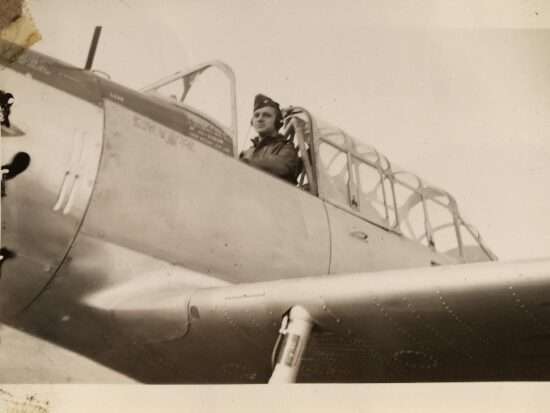 Bad weather inhibited the progress of the mission, and the Allied group was attacked en route by German fighter planes. Lt. Suiter’s plane was hit and crashed near Emmen in Drenthe, a northeastern Province of the Netherlands. Lt. Suiter was able to eject and survived the crash with superficial wounds but was captured by the German Wehrmacht (armed forces) and taken to Dulag Luft, a transit prisoner-of-war (POW) camp. Lt. Suiter was transferred to Stalag Luft 1 near Barth in northern Germany in December 1943.
Bad weather inhibited the progress of the mission, and the Allied group was attacked en route by German fighter planes. Lt. Suiter’s plane was hit and crashed near Emmen in Drenthe, a northeastern Province of the Netherlands. Lt. Suiter was able to eject and survived the crash with superficial wounds but was captured by the German Wehrmacht (armed forces) and taken to Dulag Luft, a transit prisoner-of-war (POW) camp. Lt. Suiter was transferred to Stalag Luft 1 near Barth in northern Germany in December 1943.
Information was slow to trickle to Lt. Suiter’s family. They were notified on December 8, 1943, that he had been missing in action since November 29, 1943. By early January 1944, the family was notified that Lt. Suiter was in a “German prison camp.”
 In a letter dated February 8, 1944, from Headquarters Army Service Forces, Mrs. May Evelyn Suiter was notified that her husband was interned at Dulag Luft. Mrs. Suiter was notified in a letter dated March 6, 1944, that Lt. Suiter had been transferred to Stalag Luft 1. As his next of kin, she was issued one package and two tobacco labels every sixty days after March 11, 1944.
In a letter dated February 8, 1944, from Headquarters Army Service Forces, Mrs. May Evelyn Suiter was notified that her husband was interned at Dulag Luft. Mrs. Suiter was notified in a letter dated March 6, 1944, that Lt. Suiter had been transferred to Stalag Luft 1. As his next of kin, she was issued one package and two tobacco labels every sixty days after March 11, 1944.
The family eventually received some mail from Lt. Suiter, but each postcard spent about four months in transit. Lt. Suiter began to receive letters, but no parcels, by mid-July 1944 when his roommate, Lt. S. C. Merens, was released from Stalag Luft 1 as part of a prisoner exchange on the Swedish ship Gripsholm in September 1944. After his release, Lt. Merens sent encouraging information via letters to May Evelyn Suiter, assuring her that her husband was in good health.
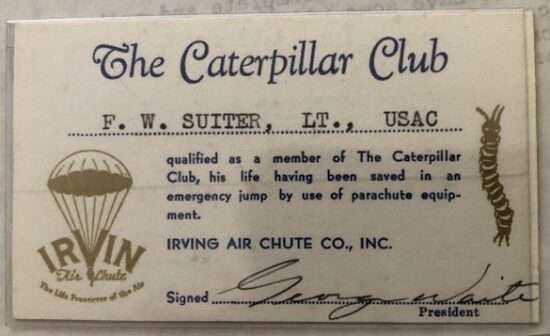 In February 1945, while still in captivity, Lt. Suiter was presented membership in the Caterpillar Club, an international organization sponsored by the Irving Air Chute Company “composed solely of those who have saved their lives by means of parachutes.” Lt. Suiter received a gold caterpillar pin and an official membership card. Both were sent to Mrs. Suiter for safekeeping while he was still a POW.
In February 1945, while still in captivity, Lt. Suiter was presented membership in the Caterpillar Club, an international organization sponsored by the Irving Air Chute Company “composed solely of those who have saved their lives by means of parachutes.” Lt. Suiter received a gold caterpillar pin and an official membership card. Both were sent to Mrs. Suiter for safekeeping while he was still a POW.
Lt. Suiter and all POWs of Stalag Luft 1 were liberated by the Russian army on May 1, 1945. Lt. Suiter detailed his liberation in a letter to May Evelyn dated May 13, 1945. He and other POWs were picked up on May 13, 1945, by American B-17s. They landed at an airfield 40 miles from Rheims, France, and were taken by truck to Rheims.
They then traveled by train to “Lucky Strike Camp,” the largest RAMP (Recovery American Military Personnel) camp, about 45 miles from Le Havre, France. Lt. Suiter sent a telegram to May Evelyn on June 21, 1945, from Camp Shanks, Orangetown, New York. He had arrived safely, was en route to Chicago, and requested May Evelyn to join him there.
Fleming Suiter was promoted from Second Lieutenant to First Lieutenant on October 23, 1945. After his return to the United States, Lt. Suiter was given 90 days TDY (temporary duty) for “recuperation, rehabilitation, and recovery.” He was stationed at Phoenix, Arizona, briefly but then was sent to Selfridge Field, Mt. Clemens, Michigan. He was part of a group of pilots who tested new planes and performed air shows around the country.
In May 1946, he wrote to his brother-in-law that he planned to take his commercial pilot’s license exam as soon as he could arrange it. He also wrote about the P-47 planes that the pilots were flying out of Selfridge at that time. Fleming complained that the P-47 wings were too small for the weight of the plane and that the P-47 wasn’t “near as fast as the P38. Anyway, we are getting rid of the P47s soon and are going to get in some P51s. I’m anxious to get to fly a P51 – to see if they are as hot as so many guys say they are.”
On August 10, 1946, four P-47s took off from Selfridge Field, Michigan, bound for an airshow in New Hampshire. Lt. Suiter piloted one of these P-47s. Reports of the following events are scarce and contradictory. The planes probably landed at an (unspecified) airfield in Massachusetts.
When they took off again, the weather was bad, overcast with rain and low clouds – visibility near zero, according to one local resident. Only three planes left Massachusetts for New Hampshire at about 2 P.M. One report claimed that Lt. Suiter volunteered to take the lead. A few minutes after take-off, Lt. Suiter radioed that something was wrong with his plane.
I shall always feel that your husband gave his life when all things were against him… 2 min before he crashed, he came in here for a crash landing 10 feet from the ground. He cut his motor but it was backfiring badly. He dipped to the left to avoid crashing the west corner of the house directly over the heads of myself and four children. He straightened it up and gave it the gun, and it took it, but only for low altitude as the clouds were so low. If ever a flier tried hard, it was him. I will always believe he wouldn’t crash land when he saw the children here…I shall never forget it as long as I live.
Lt. Suiter’s P-47 flew about two miles west of the Sizemore home, then circled back toward Grenier Airfield, Manchester, New Hampshire. His plane may have clipped treetops, but in any case, it caught fire and nose-dived into a wooded hillside “on Bridal Road near Bartlett’s family home” outside of Antrim, New Hampshire.
The plane exploded on impact with the ground. After the fire from the explosion, very little could be found of the wreckage of Lt. Suiter’s body and personal effects. The Army Air Corps detachment from Grenier Field kept local sightseers at bay, reduced publicity to a minimum, and quickly cleared the wreckage site.
Several newspaper reports erroneously put the crash in New York. The two other airplanes from Selfridge continued to Grenier Field. Most observers claimed that Lt. Suiter would have made Grenier Field if his plane had held up for five more minutes.
Lt. Fleming William Suiter was buried at Rome-Proctorville Cemetery, Lawrence County, Ohio. His Army Air Corps comrades were his pallbearers. Three planes from Selfridge Field flew over the cemetery during the services in formation, leaving a vacancy for Lt. Suiter on the right wing.
One of his pallbearers was George Molnar, who had been a navigator on a B-17 that Fleming’s P-38 squadron had escorted to Bremen, Germany, on November 29, 1943. Molnar’s B-17 was also shot down, and he spent the remainder of the war with Fleming at Stalag Luft 1.
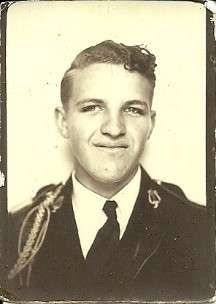
Kenneth Suiter
Fleming’s brother Kenneth Suiter, served in the U.S. Army during WWII.
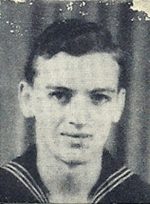
Roland Darby Suiter
Fleming’s brother Roland Darby served in the U.S. Navy in 1945-46 and was assigned to the Band Corp, playing in the Fleet City Orchestra.

0 Comments